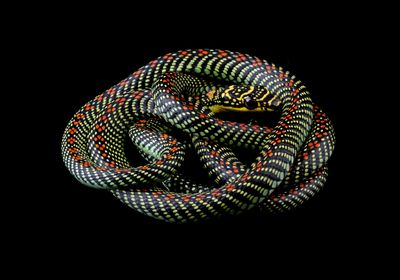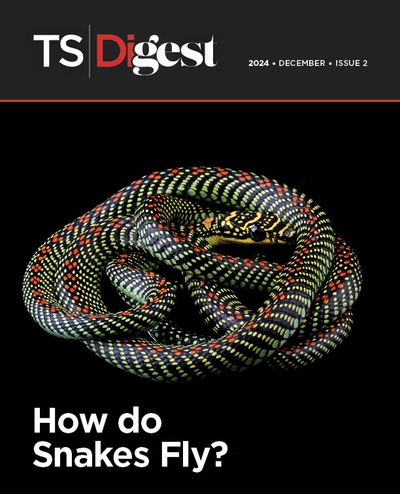How Do Snakes Fly?
Changing body shapes and coordinated wiggling provide lift and stability for gravity-defying reptiles.
For animals that live in the treetops, gliding is an energy-efficient strategy for making a quick getaway from potential predators or obtaining a tasty treat from the neighboring tree. It is perhaps unsurprising then that gliding has independently evolved in many different vertebrate groups.1 Most of these animals—like flying squirrels, sugar gliders, and Draco lizards—have developed large, wing-like folds of skin between their fore- and hindlimbs to create lift and prevent them from simply plummeting to the ground.
The paradise tree snake, of course, has no limbs to which such a membrane might be attached, and its noodle-shaped body does not seem ideal for generating lift or stability— yet somehow it is able to glide for several meters. This is exactly the kind of biophysical mystery that Jake Socha, an organismal biomechanics researcher at Virginia Tech, is drawn to solve. “I am very attracted to things that seem like they shouldn't work,” he said.
Socha’s work revealed that during gliding, the snake’s body shape transforms: normally vaguely circular in cross-section, the snake splays its ribs open, forming a triangle with a wide, slightly concave bottom. When Socha’s team analyzed the aerodynamic properties of this shape, they found that it generated surprisingly high amounts of lift when tilted at a 35-degree angle, identifying a mechanism that contributed to the snake’s gliding ability.2
Researchers also wondered how the reptile maintained stability in the air, executing a smooth glide rather than a tumbling fall. Taking advantage of a four-story black box performance space on campus, Socha’s team used high-speed motion capture to precisely measure the snake’s movements during the glide and develop a mathematical model. Using the model, they determined that the observed side-to-side undulation in the air—similar to the classic serpentine slither that snakes use to get around on land—boosted stability during gliding.3
- Dudley R, et al. Ann Rev Ecol Evol System. 2007;38:179-201.
- Holden D, et al. J Exp Biol. 2014;217(3):382-394.
- Yeaton IJ, et al. Nat Phys. 2020;16(9):974-982.


